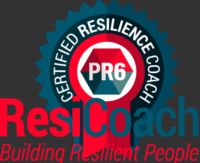How Resilience Is Your Team?
Using the PR6 resilience model we can now understand how effective teams are at working together to build resilience. The PR6 resilience model was developed from the study of the human mind. Years of research has led us to an understanding of the core elements that make up resilience.
The PR6 was scientifically validated as a psychometric scale with a Cronbach's alpha of .7365! For those of you playing at home, the closer the score is to 0.9 the higher the internal consistency or in laymen terms how closely related a set of items are as a group.
So, what exactly is resilience?
Quite simply, resilience is the capacity to recover quickly from adversity. It is a construct of mental toughness. One off the hallmarks of any successful organisation is resilience. The hardier the constitution, the more likely you are to succeed. As the saying goes, a team or organisation is only as good as its weakest member.
Why Is Resilience Important?
It is a tough world out there today. We all have so many distractions and life can get overwhelming at times. Before you judge a poor performing employee too quickly stop and ask yourself what is going on in their life and how that might affect you as well? Put yourself in their shoes. You might find that they are not a bad employee, they just need some help to cope with life's many challenges both inside and outside of work.
Being a savvy business mind, you think that there must be a way to measure, test and thus predict an employee's level of resilience as there is with any metric. And in fact there is. But, before we can get into that we must understand resilience to be able to predict it. Resilience can be broken down into 6 components that if nurtured will improve a person's resilience.
Six components of Resilience:
1.Collaboration
The first is collaboration. This need comes from the right prefrontal cortex. A natural human need is to belong. Belong to a family, a group, a nation, a team etc. This is our life line, our sense of purpose and this need for support networks is the key foundation piece of a team. People work twice as hard for those they care about and respect. So, give your team a reason to work for each other.
2.Vision
This need for a vision stems to a few different parts of the brain. Brain activity in relation to vision is seen in the Hippocampus, the Pre-Frontal Cortex and the Ventral Stratum.
Your new tight-knit team is in search of a purpose. Give them a worthy goal along with the confidence to do it and help them see the good that will come from their efforts. A well team motivated will work for each other towards a goal they believe in is a powerful asset.
3.Composure
Now enter the outside world. Your well motivated team is going to face adversity from inside and outside of the organisation. A sign of high resilience is your composure under pressure. The Pre-Frontal cortex is also involved in composure.
This is a critical step in the PR6 model. A great leader will find ways to help their team practice their composure, to keep their calm and execute the teams goals no matter the situation or adversity faced.
4.Reasoning
Reasoning goes hand in hand with composure. The definition of composure is to reason and solve problems while under pressure. Reasoning comes from both the left and right Frontal cortex and the anterior cingulate cortex.
A successful plan for facing adversity will go a long way towards successful reasoning. A well-prepared team is a team ready to face challenges and persevere.; with the ability to apply reasoning to any situation rather than panic and anxiety.
5.Health
This may seem to be the most obvious one. Great companies in the world are starting to realise the benefits of encouraging employee well-being. Offering gym memberships and healthy options for the in-office lunch show great results for the organisations that invest in them. A healthy work force is a happy work force.
6.Tenacity
Finally, tenacity. With collaboration, vision, composure, reasoning and health all running at peak efficiency all that is left to encourage is the never say die attitude. Nurturing a winning environment is important to putting all of this together and generating a resilient team.
How Do We Measure Our Teams Resilience?
The PR6 model measures momentum. Momentum gives us a forward-looking predictive model to help show the likely direction of development.
This model is used in clinical setting and for general coaching purposes. It helps to find problem areas so that you can strengthen those weakest links, to have the best possible change. The PR6 model is even used for sports teams and schools. It is applicable anywhere resilience is required and every team can always improve upon their resilience.
The results come complete with action plan suggestions to help being the strengthening. We are able to get results for individuals and for whole teams. It is useful on the professional and personal level for those reasons.
To learn more about resilence training click here or to book a FREE demo.



)
)
)
)
)
)
)
)
)
)

